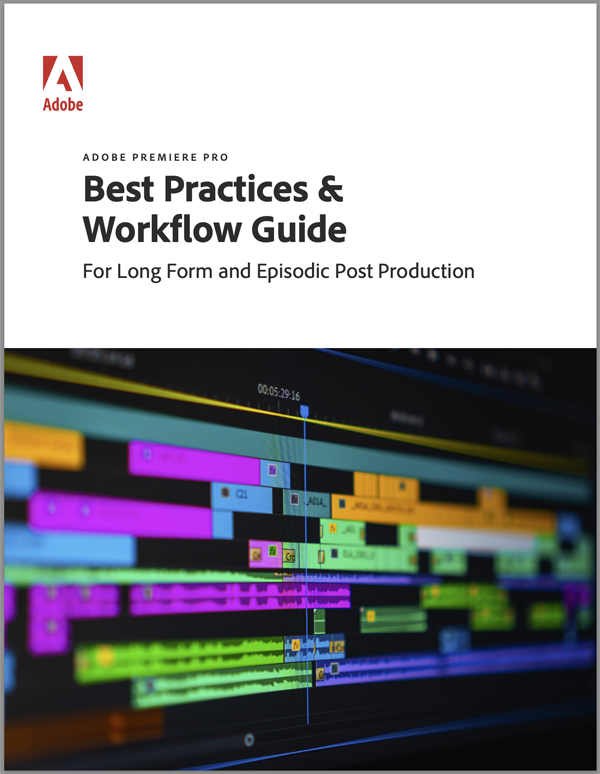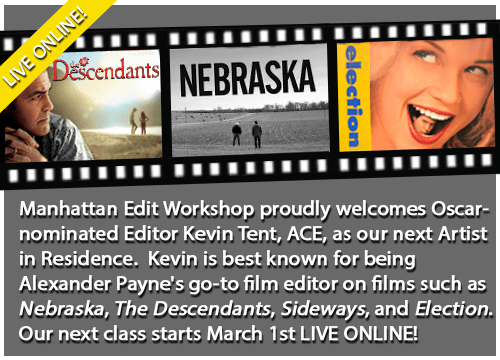ACE Member News, ACE News (Home)

Adobe releases comprehensive Premiere Pro Guide for long-form and episodic filmmakers
As a leader in the post-production industry, Adobe is dedicated to supporting the filmmaking and entertainment community. For nearly two decades, Adobe has evolved Premiere Pro into a trusted editing platform for, amongst other things, long-form and episodic content.
To continue our support, Adobe has developed a Premiere Pro best practices and workflow guide created specifically with film and television editors in mind.
Read the complete article HERE
Download the comprehensive guide HERE
ACE News (Home), International
Global Editing Perspectives: The Impact of COVID-19
By Edgar Burcksen, ACE, NCE
A year ago in the U.S, our industry was hit hard when due to the novel coronavirus studios stopped production and theaters shut down, robbing the industry of a major platform for their releases.
I was in the final phases of editing a documentary and although we did not stop work, facemasks, rubber gloves, hand sanitizers and social distancing were strictly implemented. We wiped down the keyboards and other equipment after use and a more or less careful normalcy let us continue until we came to a stop when we had to do the color timing and mixing, until the facilities reopened. The production shut down the editing room and the Avid sits now in my home office from where I can take care of business remotely.
With remote working now an irreplaceable part of our professional lives, I was wondering how our colleagues abroad fared with the pandemic in their work place. (For the latest number of cases per country, CNN is regularly updating figures: https://edition.cnn.com/interactive/2020/health/coronavirus-maps-and-cases/
Australia
Australian Screen Editors President Fiona Strain, ASE reports that their government was quick to set in place travel restrictions, while everyone entering the country must go into supervised hotel quarantine for two weeks and be tested after ten days and again after 14 days.
Still, she reports that the Australian government was slow to offer support to the industry, with its initial packages aimed at businesses and workers who were employed for a minimum of 12 months by a single employer. This meant that the majority of film industry workers who are mostly freelance were not eligible. Later the federal government introduced specific packages to film industry funding bodies to enable COVID safety measures to be implemented on set, and to encourage film-making generally, she said.
“Individual Australian states have funding packages for the Arts in general, but not much is aimed at the motion picture sector. However, in a move that the editors are incredibly disappointed about, the federal government relaxed Australian local content regulations on broadcasters during the pandemic,” she said. “The broadcasters argued because of production shutdowns they would not have the content needed to put on the screen. This means that broadcasters are no longer required to produce Australian children’s content, and they have also relaxed requirements on Australian drama and documentary production. Streaming services such as Netflix have no obligation to produce Australian content anymore.”
However, the country’s no-nonsense approach to containing the virus is paying dividends. Postproduction facilities have reopened up more with a combination of work from home and on-premise arrangements.
“The film industry here has picked up strongly,” Strain says. “There are predictions of a boom for the next year or two as we have COVID mostly under control and we are seen as a safe option for offshore production plus our exchange rate is favorable. Australian cinemas have re-opened with reduced seating capacity, but there is a feeling that there will be more streaming releases ahead of cinema releases.”
Canada
The federal government stepped in with income support initially to replace lost income for all freelance workers (including film workers). “When that program ended it was replaced by Unemployment Insurance that is actually easier to access,” says Stephen Philipson, CCE, president of the Canadian Cinema Editors. “In terms of the industry measures, the unions and other stakeholders collaborated across the country to create ‘back to work’ safety standards, however it is up to provinces to decide whether film productions can continue to shoot and the exact measures taken vary by province (for example in British Columbia more testing is required).
He adds, “A significant amount of post production has been happening remotely and many producers are encouraging it whenever possible, however some labs have reopened recently with safety measures in place.”
India
While countries including Canada, The Netherlands and Israel locked down early and were able to contain major damage, in India the lockdown resulted in disaster. Hundreds of thousands of workers employed in the big metro cities had to walk back or hitchhike home to their native state without public transportation, explained editor Kiran Ganti.
“All production was forced to stop by March 25 as a nationwide lockdown was announced,” Ganti related. “Work on a few projects even in Mumbai, continued through April and May and some web-series were released in July. The situation remained the same till early July when some postproduction work was allowed in Hyderabad, Bengaluru, Kerala and Chennai with studios opening their facilities.”
By November, post-production work on many films across India has resumed. Shooting of some of the biggest films in Mumbai began although that wasn’t the case in the other three major film producing centers of Southern India, which account for 70 percent of the nearly 1000 films that are made in India annually, Ganti said.
According to Ganti, collaborative work in physical proximity is something that many are longing for. “Yes, precautions are being taken and aspects like social distancing, checking where to order food from and maintaining personal hygiene have become important. But it would be an exaggeration to think that remote editorial work will be the new normal. Technical, logistical, and social factors will limit the widespread adoption of remote editing.”
The Netherlands
The government quickly set up a help fund that carried lots of film professionals through the first months. But as the majority of film professionals there are self-employed and the measures were more set up for employees, many Dutch editors didn’t get much further assistance. The pandemic and the lockdown struck the Dutch cultural sector very hard as cinemas have been closed or restricted for the entire period.
Editors set up home studios and started working from home. The transition was smooth, helped by the fact that almost all Dutch editors work on their own equipment in their own edit room anyway.
South Africa
Nikki Comninos, SAGE of the South African Guild of Editors noted that although South Africa has had a high number of infections, their recovery rate is quite high. “Postproduction was badly affected by the lockdown and many editors didn’t have any income at all,” Comninos reports.
“The only editors who could continue working were those who were already in the midst of post production or those working in current affairs. There were measures to help with people in the film and TV industry. However, there wasn’t enough funding available for everyone and only those whose productions were cancelled and had contracts to prove this, received financial assistance. This meant the bulk of South African freelance workers who rely on the tenuous but consistent flow of work without contracts or much forewarning were left stranded.
“Producers are open to allow people to work remotely. But rates seem to be lower with producers even asking for ‘your best COVID rate.’”
South Korea
“The country handled Covid-19 quite well in the beginning,” explains editor Yang Jinmo, ACE (Parasite). “We were very quick to wear facemasks and practiced social distancing.” Yang set up remote editing by request from Netflix just to prepare for the worst case. This project, The Call, was released on Netflix in South Korea recently.
A big thank you to all our colleagues who contributed to this article.
ACE Member News, ACE News (Home)
 The next installment of MEWShop’s Six Week Intensive Workshop will be taught LIVE online beginning on March 1st, 2021 and will be held Monday through Friday from 10 AM EST to 6 PM EST.
The next installment of MEWShop’s Six Week Intensive Workshop will be taught LIVE online beginning on March 1st, 2021 and will be held Monday through Friday from 10 AM EST to 6 PM EST.
“Having Kevin Tent, ACE join our next class is a special event for our students,” says MEWShop Director of Education Janet Dalton. “His decades of experience in editing; as well as a director will give our students unparalleled insight.” MEWShop’s early bird pricing for $500 off ends on February 19th.
For more information on the Online Six Week Intensive Workshop or to register, please visit https://www.mewshop.com/six-week-intensive-online.
ACE News (Home), News

Sight, Sound & Story: Live Online with “Behind the Lens with DP John Simmons, ASC” on August 19th
The Second Episode Features Acclaimed Cinematographer John Simmons, ASC and Moderated by Snehal Patel from ZEISS
Manhattan Edit Workshop’s “Sight, Sound & Story: Live” monthly online event series continues this August with acclaimed Cinematographer John Simmons, ASC.
Inside Episode II: An Emmy-winning cinematographer and celebrated photographer, John Simmons, ASC has had an illustrious career which spans nearly four decades. During this conversation, Johnny will reflect on the opportunities that led him on this upward trajectory in the film industry. Learn how other art mediums, such as painting, informed his lighting techniques on-set as a cinematographer, as we examine some of his earlier television work. We will also discuss the importance of mentorship – Johnny’s guidance has impacted many up-and-coming filmmakers working today – and his role on the ASC Vision Committee, which promotes the advancement of underrepresented cinematographers and film community at large.
Moderated by ZEISS Cine Sales Director Snehal Patel.
All attendees who register for this event will receive a link and password to Vimeo Live an hour prior to the event. This will gain free access for all attendees who register. There’ll be live raffles throughout the event, but attendees must be present.
Our event wouldn’t be possible without our Master Storyteller Sponsors: OWC, ZEISS, American Cinema Editors, & EditFest Global; as well as our Technology Sponsor: Shutterstock. Following the panel there will be a chance to ask questions in a live Q&A networking event. To register, please go to https://bit.ly/31SKGLr.
Our next Sight, Sound & Story: Live event will be on September 16th. Please go to www.SightSoundandStory.com for up to date information.



